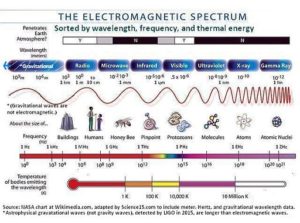
In current astrophysics, specialized tools are exploring different wavelengths in the gravitational and electromagnetic spectrums.
The year 2015 saw two firsts in astrophysics, both of which were first reported in February, 2016: Repeated Fast Radio Bursts, and Gravitational Waves were detected, coming from outer space.
The Repeated Fast Radio Bursts were detected by the Parkes radiotelescope in Australia, and the related redshift was subsequently confirmed by the Subaru optical telescope at Mauna Kea, Hawaii.
The gravitational waves were detected by the newly constructed Advanced Laser Inferometer Gravitational-wave Observatory (“Advanced LIGO”).
In both cases, astrophysicists focused attention on trying to identify the source of the phenomena.
These detections brought to the forefront the breadth of astrophysics and the ways we now study astrophysics, based on predictions from Einstein’s theory of General Relativity.
To understand these new discoveries, it is helpful to review the components of the electromagnetic spectrum and the relationship of gravitational waves to that spectrum.
Light is a form of electromagnetic (EM) wave. An EM wave is an electric field and a magnetic field that are oscillating together.
The fields are oriented perpendicular to each other, and the wave travels in a direction perpendicular to both of the fields. These waves can also be thought of as particles called photons: massless packets of energy that travel at the speed of light. In fact, EM radiation behaves as both a particle and a wave at the same time.
EM waves can be characterized by any of three properties: wavelength (?) – the distance between two adjacent crests of the wave, frequency (f) – the number of wave oscillations per second, or the energy (E) of the individual photons in the wave.
So begins a comprehensive article on the characteristics of different types of waves comprising the electromagnetic spectrum, and characterized in one manner as made of photons, with an additional characteristic of EM waves being that the energy of EM waves is bidirectional.
Now, with the detection of gravitational waves, astrophysicists have proven the existence of another type of wave that is not made up of photons, and of which the energy of waves is not bidirectional, like EM waves, but instead is unidirectional. These are gravitational waves (GW). The GM wavelength is longer than that of EM waves, and it has been suggested that, in place of the EM wave “photons,” the unidirectional gravitational wave particles would be “gravitons.”
Visualized on a continuum in the above chart modified from a NASA chart of the electromagnetic spectrum, the longest electromagnetic wave, or radio wave, seems to lead into the wave-length area inhabited by gravitational waves.
Today’s astronomers and astrophysicists study the universe not only with visible light, but also with radio waves, infra-red light, and even x-rays, all of which are part of the electromagnetic spectrum; but now, with the ability to detect gravitational waves from outer space, it appears the general consensus that a new era of astrophysics and astronomical discovery has commenced.
For more on this subject, see www.ligo.caltech.edu
To see a 1-1/2 hour video wherein theoretical physicist Stephen Hawking explains the significance of the discovery of gravitational waves, as validating his life’s work, visit the next page.



